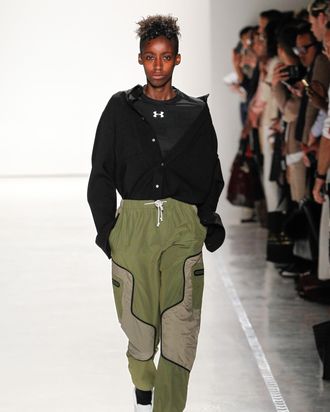
Every time an email announcing a new brand of $300 leggings lands with a thud in my inbox, I wonder how much longer upscale athleisure can enrapture us. Don’t get me wrong, I’m all for 24/7 comfort and ease, but when a new brand of overpriced spandex rears its head, I feel like Steve Carell’s character in The Big Short, staring straight at a mortgaged-to-the-gills Florida McMansion: How long can this keep going on?
Maybe not that much longer. Industry site the Robin Report predicts that athleisure “is rolling over for fall and its growth rate will dramatically slow, and then stall out.” That doesn’t mean that activewear will ebb, necessarily — they’re talking about the much-vaunted concept of wearing high-end athleticwear as fashion.
While I’m not entirely convinced by the report, they did gather some interesting evidence. Yoga pants were once predicted to replace jeans entirely, but the retail buyers they spoke to are buying more denim and less athleisure for the coming season. They also pointed to athleisure becoming even more mass, with efforts like Victoria’s Secret’s VSX brand and Under Armour starting to sell at Kohl’s. But as with any overarching trend — normcore, minimalism — it was only a matter of time before the inevitable shift in the opposite direction. We’ve been treated to celebrity activewear lines from Beyoncé, Rihanna, and, well, Rita Ora. Leather workout pants came on the scene. Riccardo Tisci and, now, Olivier Rousteing have collaborated with Nike on fashionable gym-rat attire. Net-a-Sporter, the e-commerce giant’s activewear division, and boutiques like Bandier have become sources for workout clothes that cost nearly as much as their ready-to-wear counterparts. In a market that saturated, it’s hard to imagine there’s much room for innovation.
One of the trickiest things about following the march of fashion is determining what is a trend and what represents an actual shift in the way we approach dressing. Christian Dior’s New Look, revolutionary as it was, was a trend. The restrictive, wasp-waisted silhouette he created would dominate fashion for years afterward, but it doesn’t have much bearing on the way we dress now. But shifts, like Yves Saint Laurent’s embrace of vintage and streetwear as high fashion, or Norma Kamali’s reimagining of then-prosaic sweatclothes and puffers, are still influencing our wardrobes today. They can be felt in everything from the rise of Vetements to the leggings-as-pants phenomenon. The accelerating casualness of everyday life isn’t stopping anytime soon — we won’t be trading in our athleisure en masse for the restrictive clothes of the past.
To use an analogy from the equally trend-obsessed music industry, maybe athleisure will turn out to be something like Auto-Tune. At its peak, extreme digital sweetening was embraced by musicians of different genres. Kanye West, in particular, used it to artistic end on 808s and Heartbreak. Pretty soon, people had Auto-Tuned news clips and even a Carl Sagan documentary. Eventually, though, everybody soured on the signature sound. Over-the-top Auto-Tune now sounds too redolent of 2009, but the technology is still there, and it’s affected the way music sounds in much subtler ways. In the same way that Auto-Tune went from a sonic statement to just another tool, full-on athleisure is probably going to feel very 2016 from the vantage point of the future, but athleisure and “soft dressing” will be here to stay in some form. (Though those high-end leggings are sure to go the way of eToys.)




